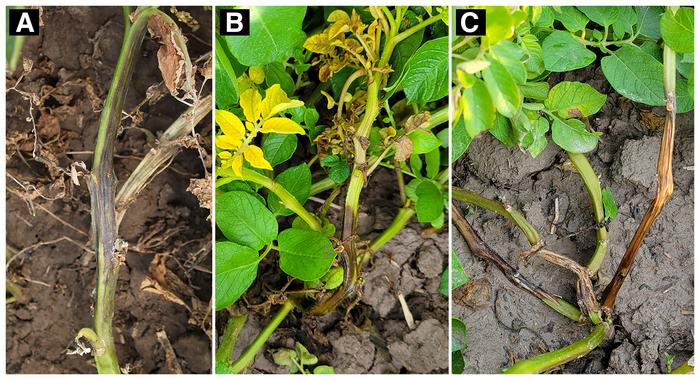Aerial stem rot (ASR) has long posed a formidable challenge for potato growers, particularly as a persistent late-season bacterial disease. Caused primarily by the pathogen Pectobacterium carotovorum, ASR emerges prominently following adverse weather events such as thunderstorms. The disease manifests as dark lesions on potato stems that quickly expand, ultimately compromising the plant’s vascular system and leading to significant yield losses. Despite its agricultural importance, effective and consistent management strategies for ASR have remained elusive until recently, leaving growers with limited tools to mitigate outbreaks.
Historically, copper-based fungicides have been considered as a potential approach to manage ASR, but numerous studies yielded conflicting or inconclusive results. Varied efficacy across different environmental conditions and treatment regimens contributed to widespread uncertainty regarding their practical value. This ambiguity prompted a comprehensive decade-long investigation led by Phillip S. Wharton of the University of Idaho, whose research has now provided definitive evidence supporting the consistent utility of copper fungicides in aerial stem rot management.
The study, published in the peer-reviewed journal Plant Health Progress in March 2025, meticulously analyzed data from over ten years of field trials across multiple growing seasons. By applying copper-based fungicides on a strict weekly schedule commencing at row closure, researchers could observe and quantify the disease’s progression from initial symptom development through peak infection stages. The relative area under the disease progress curve (AUDPC) was used as a sophisticated statistical metric to precisely measure ASR severity and spread within trial plots over a four-week monitoring period.
Results revealed that copper fungicide treatments substantially mitigated the severity and expansion of ASR lesions compared to untreated controls. Although some individual years showed less pronounced differences, the aggregate data over the decade unequivocally demonstrated reduced disease incidence and enhanced crop yields in treated plots. The study’s quantitative analysis established an average yield improvement of approximately three tonnes per hectare, equating to roughly 27 hundredweight per acre, highlighting the tangible economic benefits of incorporating copper fungicides into late-season disease management protocols.
Crucially, this research also clarified the pathogen’s infection biology and epidemiology, distinguishing aerial stem rot from other closely related bacterial diseases such as blackleg. While blackleg bacteria initiate infections through seed tubers and colonize plants from the soil upward, Pectobacterium carotovorum invades potato stems via canopy wounds, including petiole scars and insect damage, resulting in distinctive black lesions that progress downward along the aerial stem. This fundamental difference explains why blackleg is unaffected by foliar fungicide treatments, whereas ASR is highly responsive to copper applications when timed correctly.
The study’s detailed disease progression analyses underscored the critical importance of initiating weekly copper fungicide sprays at the observed phenological stage known as “row closure,” when potato plant rows grow sufficiently to form a canopy. This timing maximizes fungicide efficacy by protecting emerging vulnerable tissues and preventing the early establishment and rapid spread of ASR lesions through the plant canopy. Researchers emphasized that deviations from this schedule significantly diminished the protective effect, reaffirming the need for disciplined application protocols.
Beyond efficacy, the study addressed potential concerns regarding copper fungicide use, particularly its compatibility with organic farming systems. Unlike many synthetic chemical treatments, copper-based products are approved for use in organic agriculture, providing a valuable disease management tool that aligns with sustainable and environmentally conscious production practices. This factor enhances the fungicide’s appeal across diverse farming operations seeking to balance disease control with regulatory compliance and ecological stewardship.
The research further reported that varying copper formulations, encompassing different chemical compounds and application technologies, delivered broadly comparable outcomes, suggesting formulation flexibility based on regional availability and grower preference. This finding allows growers to select products optimized for local conditions without compromising treatment effectiveness. However, the authors caution against reducing application frequency or dosage below proven thresholds, as suboptimal use may lead to inconsistent disease control and potential resistance development.
The decade-long scope of this investigation gave unique insights into the spatiotemporal dynamics of ASR and copper-fungicide interactions across fluctuating environmental conditions. Researchers monitored variable weather patterns, host cultivar susceptibility, and pathogen population pressure to affirm the robustness of copper treatments under realistic commercial growing scenarios. The longitudinal data set strengthened confidence that copper fungicides can deliver reliable disease suppression year after year, providing growers with a resilient management strategy against late-season bacterial challenges.
This research represents a milestone in potato pathology by delivering the first thorough, systematically controlled evaluation of copper fungicide applications specifically targeting aerial stem rot. It equips the global potato production community with actionable science-based guidelines, ensuring that ASR can be managed more effectively than ever before. These findings are expected to influence integrated pest management programs, extension recommendations, and fungicide usage policies worldwide.
In summary, this landmark study confirms that copper-based fungicides, applied on a weekly schedule starting at row closure, offer a scientifically validated, cost-efficient solution for managing aerial stem rot in potatoes. By differentiating ASR from similar diseases and rigorously validating treatment efficacy, this work advances sustainable disease control practices. As growers adopt these protocols, they can anticipate healthier crops, improved yields, and greater profitability, transforming the outlook for potato production in regions where ASR has historically curtailed crop performance.
For growers, researchers, and crop consultants alike, these insights underscore the enduring value of copper fungicides as a practical tool in aerial stem rot management. Coupled with continued vigilance and integrated pathogen monitoring, this approach promises to safeguard potato health against one of its most persistent bacterial enemies.
Subject of Research: Management of aerial stem rot (ASR) in potatoes using copper-based fungicides
Article Title: Ten-Year Trends in Aerial Stem Rot Management: Evaluating Copper-Based Solutions for Sustainable Potato Cultivation
News Publication Date: 24-Mar-2025
Web References:
https://doi.org/10.1094/PHP-08-24-0085-RS
https://apsjournals.apsnet.org/journal/php
Image Credits: Courtesy Phillip S. Wharton—© 2025 The American Phytopathological Society
Keywords: Aerial stem rot, Pectobacterium carotovorum, copper fungicides, potato disease management, plant pathology, bacterial pathogens, crop yield improvement, organic farming, integrated pest management, late-season diseases




